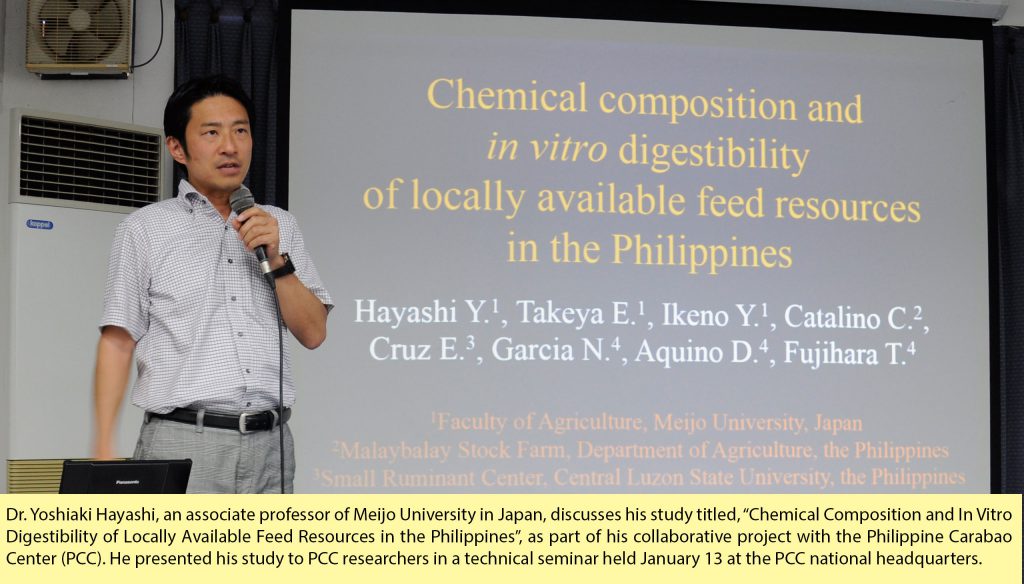An associate professor from the Laboratory of Plant and Animal Science of Meijo University, Japan has presented a study titled “Chemical Composition and In Vitro Digestibility of Locally Available Feed Resources in the Philippines” before some 40 researchers of the Philippine Carabao Center (PCC) and visiting students in a technical seminar held January 13 at the PCC national headquarters.
Dr. Yoshiaki Hayashi is currently engaged in a collaborative project with PCC titled, “Evaluation and Utilization of Locally Available Feed Resources for Ruminant Production in the Philippines” which started in 2013.
As part of the joint endeavor, Hayashi conducted his study in the context of a growing demand for milk and meat in tropical Asian countries vis-à-vis feed shortage due to water deficiency during dry season and some issues related to feed productivity.
There are many varieties and yields of locally available feed resources in the tropics. According to Hayashi, while many researchers have already conducted experiments related to feed materials, there are only few reports on chemical composition and in-vitro digestibility on the resources in tropical areas, hence, his study.
The research team, led by Hayashi, did a sample collection in Nueva Ecija and Bukidnon provinces in July 2013 (hot-wet period), October 2013 (cool-wet period), February 2014 (cool-dry period) and May 2014 (hot-dry period) covering four seasons to measure the chemical composition and in-vitro digestibility of the different varieties of feed resources. The sample included different forage families such as Gramineae/Poaceae, Fabaceae/Leguminosae, Acanthaceae, Euphorbiaceae, and Moringaceae.
The chemical composition includes dry matter, organic matter, crude protein and neutral detergent fiver while the procedures used in measuring digestibility include rumen fluid collection of goats mixed with artificial saliva and dried resource samples.
As a result of his study, the dry matter content of the samples was higher in dry season than in wet season. Fabaceae/Leguminosae tended to be higher than Gramineae/Poaceae in terms of crude protein but lower in terms of the neutral detergent fiver content. Also, digestibility in dry season tended to be lower than in wet season.
“Some of the samples collected like Brizantha, Dwarf Napier (Gramineae/Poaceae), Arachis pintoi (Fabaceae/Leguminosae) and Moringa (Moringaceae) are considered to have high values as feed resources in terms of chemical composition and digestibility. The periods divided by the climate caused variance of chemical composition and in-vitro digestibility of locally available feed resources, that’s why we should consider choosing appropriate resources in different periods for efficient nutrient application to livestock,” Hayashi explained.
According to Dr. Daniel Aquino, PCC animal nutritionist and one of the researchers involved in the study, the collaborative program’s future plan is to engage the entire PCC network nationwide, including Bureau of Animal Industry (BAI) livestock farms, small ruminant farms and 45 PCC-assisted dairy cooperatives in its National and Regional Impact Zones, in the sample collection and analysis of feed resources in their respective areas.
“I think this project is truly necessary because up to now we don’t have an updated and concrete published information on the nutrient composition of the different feed resources in the Philippines,” Aquino stated.
On the other hand, Phoebe Llantada, PCC science research assistant, considered the project and study as an open window and baseline for pasture and forage establishment in the country.
Also included in the future plan for the study is the selection of samples of feed resources in the areas mentioned by Aquino. The samples will include not only those purposely planted but also those naturally occurring for the analysis of its nutritive value all throughout the year. The selection is scheduled to start in February this year. Moreover, in terms of studying in-vitro digestibility, the researchers will now use rumen fluid from buffaloes instead of goats.

